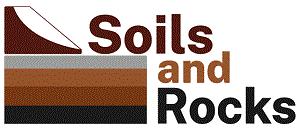Abstract
Several regions in Brazil and the world suffer from the presence of collapsible soils. The development of theories for understanding the phenomenon is significant because the increase of water content is associated with several reasons (e.g., precipitation, rupture of sewage, and water systems). Although some theories explain the behavior of various types of soils, they fail to explain collapsible and structured soils. In this research, an alternative interpretation of the consolidation theory is verified and calibrated for collapsible soil. The alternative model was applied to experimental data from a latosol from southeastern Brazil, and comparisons with the classical theory showed a difference in the saturated hydraulic conductivity of around 100 times. The observation showed promising results compared with the saturated hydraulic conductivity of the field (Guelph Permeameter). Furthermore, consolidation tests verified the collapse potential, the variation of consolidation coefficient and saturated hydraulic conductivity, and the total settlement prevision due to the presence of bleach and washing powder.
Keywords
Consolidation; Collapsible soils; Collapse by contamination; Collapsibility index

 Experimental evaluation of the classical and alternative consolidation theories in predicting the volumetric change of contaminated and non-contaminated soil
Experimental evaluation of the classical and alternative consolidation theories in predicting the volumetric change of contaminated and non-contaminated soil Thumbnail
Thumbnail
 Thumbnail
Thumbnail
 Thumbnail
Thumbnail
 Thumbnail
Thumbnail
 Thumbnail
Thumbnail
 Thumbnail
Thumbnail
 Thumbnail
Thumbnail
 Thumbnail
Thumbnail
 Thumbnail
Thumbnail
 Thumbnail
Thumbnail










